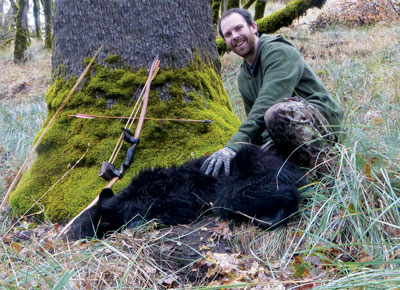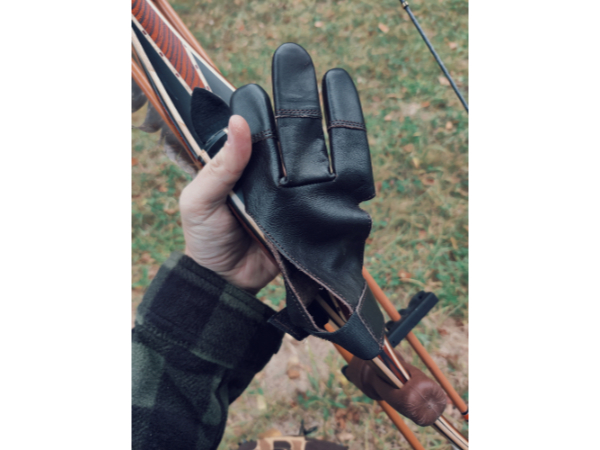It can be easy to read stories and watch shows of other hunters and become consumed with the “it’s always greener on the other side” frame of mind. But I’ll bet you have hidden treasures in your backyard. It could be endless acres of squirrel, rabbit, and woodchuck habitat. Maybe you live near a unique ecosystem, like the heartlands where my friend hunts whitetail deer. I happen to be blessed to live in a location with an abundant black bear population and millions of acres of public land to chase them.
To be a competent hunter requires the acquisition of knowledge concerning the natural history of your quarry. For me, this involves putting in the time to see how an animal lives. How does the phenology of plant growth affect what that animal is eating throughout the year, and where can those plants be found? What does this animal’s sign look like in the forest, and how can you differentiate males from females and adults from juveniles? What is the best method for getting close to them?
Every year I spend two or three months tracking, watching, and learning about black bears, outside of the hunting season. In the fall I spend another two or three months hunting them. I have access to both wilderness and day-length bear hunting locations. Across the broad region, there are bears everywhere. However, on a finer scale bears are found in specific habitat types depending on what food is available. I incorporate several styles of hunting for bears: ambush (sitting along a bear trail or by food), spot-and-stalk, and sneaking around (still hunting).
Ambush hunting has resulted in my closest shot at a bear. Instead of shooting, I could have reached out and poked the bear with my arrow as it walked by. However, spot-and-stalk and sneaking around are my favorite methods, because bears are made for the close ranges traditional bowhunters require. A bear walking through the woods with a destination in mind moves quickly, a little too fast for me to keep up while being quiet (until it starts raining). A foraging bear, even if it is just nosing logs for ants, provides the hunter with time to move. And while I hunt as much as I can, there are specific days in the fall that are perfect for getting close.
In 2016, I hunted bears for twelve days: two four-day backpack adventures; a weekend backpack hunt; and two day-trips. Near the end of my season I had seen over a dozen bears. My closest encounter was measured in feet, when I came close enough to grab a cub. Since I was between it and the sow, I felt relieved to see her run the other way. However, even with all the bears I had seen I had not loosed an arrow, not until a big storm rolled through in early October.
There are three circumstances I watch for every fall when bear hunting: 1) the saddle oak mast crop; 2) the first big storm that will knock acorns to the ground and quiet the woods for stalking; 3) the first snow. In this country, each of these situations increases the likelihood that I’ll have an opportunity for a shot. Having already hunted the saddle oak mast and passed on a shot because it was early in the season, and with one bear tag per year I did not want to fill it too quickly, I was looking forward to our first big cold front. When a storm came to town, I made sure to hit the woods and stalk bruins.
Clouds rolling up the valley and through the trees moistened the air, and the freshness of winter’s first touch crept up my nose as I sneaked through an oak woodland. A light breeze would rustle leaves and twigs, interrupting the pitter-patter of rainfall. Soft footfalls in damp earth and fat acorns on the ground gave me hope that I would encounter an animal. After hunting for a few hours, I spotted a bear as I walked past the trunk of an old white oak. The bear stood fifteen yards below me, facing directly away and picking up fallen acorns.
I sidled up next to the oak for added cover, nocked an arrow and watched, scanning the woods and oak canopy for cubs. With visibility extending out to 100 yards in the treetops and seventy on the forest floor, I felt confident no cubs were around. The breeze held steady, quartering across from the bear to me as I watched and waited. I lacked the symptoms of buck fever, and with an unusual air of calmness I allowed time for the bear to present me with a good shot opportunity.
A few minutes later it turned broadside, slightly quartering away. I drew, anchored, and aimed. When all felt right, I released. When the arrow slipped completely through the bear’s rib cage, it jumped, did a 180, and then stood there looking around. I started counting at the moment of impact, and between three and four seconds it fell over. After a few labored breaths and a couple moans, life faded from the bear. All of this took place fifteen yards from me and in plain sight. This was the first time I had watched an animal I shot with an arrow die in front of me. The experience is not something that can be conveyed with words, although I try. It can only be known through direct experience.

The bear the author took in front of the old white oak that provided acorns for generations of bears and concealment for the hunter.
The bear turned out to be an old sow. Her teeth were worn down and stained. Her eyes had corneal edema (an opaque fluid in the membrane over the eye), and her breasts were dry. She had likely seen at least twenty winters and raised many litters of cubs. Her stomach had atrophied, and this late in the season she was noticeably absent of fat. It was unlikely she would have lived through the winter. It had been a mercy kill, as my friend Matt Nelson says, although I didn’t know that at the time I released my arrow. I always feel like a greenhorn in the presence of wild animals that live to an old age. Imagine what she must have known?
The hike back to my truck was barely over a mile, yet the 500 feet of steep hillside required me to skin and quarter the bear in the field. I packed out the meat, hide, and skull on my back. I wasn’t worried about the meat spoiling or yellow jackets showing up, due to the cold temperature. Therefore, I took my time skinning, quartering, and packing the meat, and with plenty of daylight left I slowly walked up the mountain, the better to enjoy the experience.
Hiking out, I felt an odd mix of happiness and mild depression. I was happy for the clean, quick kill, the meat on my back, to have been so close to a wild animal, and to have participated in nature. I was mildly depressed because this meant the end of my bear season, and I love to hunt bears. I have come to realize that the place where I live is magical. The deer may not yield as many shots as folks get in the Midwest, and I cannot pursue elk with over-the-counter tags. But man, there is some excellent bear hunting.
Equipment Note: On this hunt, Preston carried a 50# Elkheart longbow by Java Man Archery, and was shooting an ICS Beman shaft with a STOS broadhead.







Leave A Comment